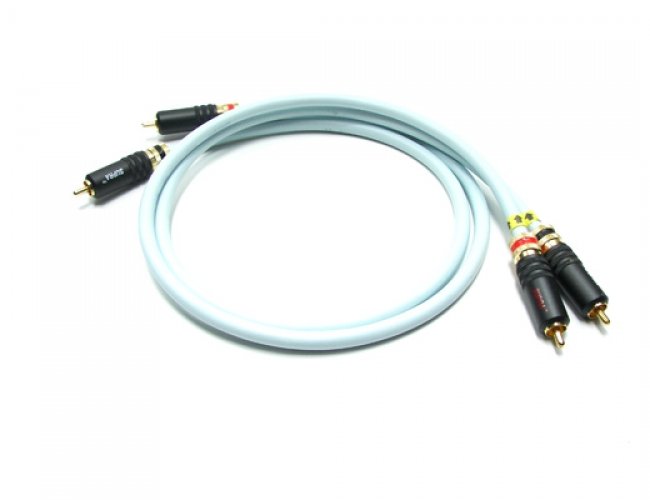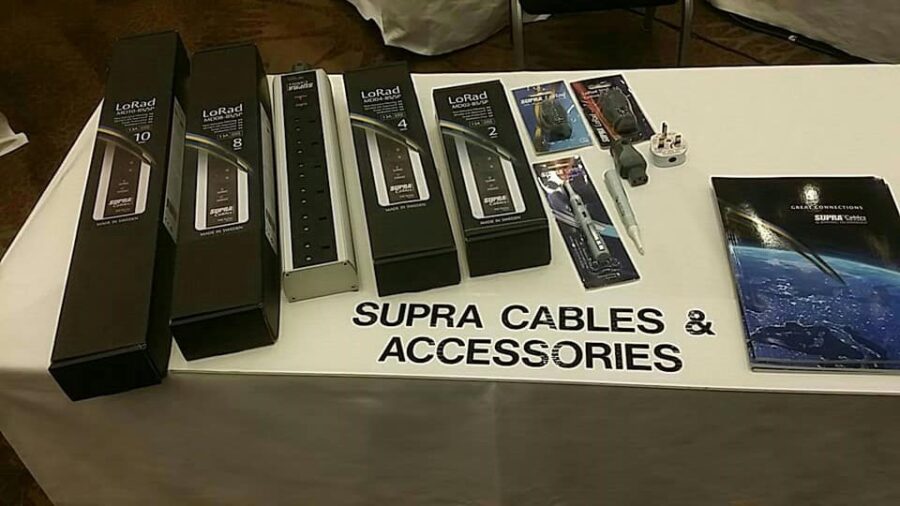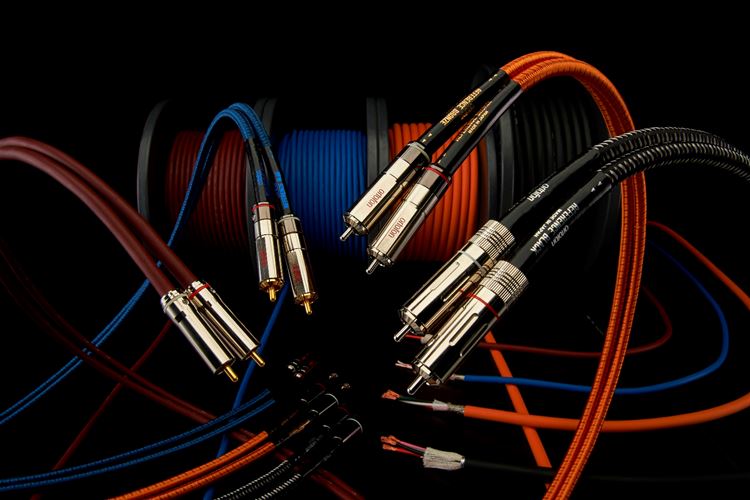Supra’s EFF-I is a 75Ohm stereo pair interconnect made of silver plated Oxygen Free Copper of 0.5 mm squared cross-sectional area, within a centre core of Polyethylene (PE). Both conductors are individually screened for use in balanced or semi-balanced configuration. The ISL prefix is pertaining to the plugs used, ISL being the locking plug version, IX being standard phono plugs and IXLR obviously applicable to the XLR balanced version.
‘These look nice!’ Supra’s trademark light blue jacket runs from plug to plug on their budget £100 interconnect, a very tough price point to position a cable in today’s market. Apart from not being boring old black though the Supra’s have some wonderful looking plugs, they are a WBT type style locking plug but are more familiar to the lower mass TQ incarceration of that style and are well constructed and feel extremely nice. Now I for one know that having the Supra’s on a stand in amongst all the other cables will automatically draw a potential buyer to them when shopping around in store. Yes looks don’t mean anything, it’s the sound that matters right? You will be surprised how many music enthusiasts still shop with their eyes, so can Supra cover both areas? Looks and sound?
THE SOUND
Instantly the Supras made an impression . Their calm, detailed and weighty sound was a different experience to that of say the RFC Pluto and Epiphany Acoustics Atratus III which in comparison were very much brighter and livelier sounding. The EFF-I in comparison were showing a wealth of confidence when reproducing electronica and music with a little more mayhem in the mix, conveying great dynamics and good strong stable imaging.
Upper end detail was not a prominent as the other two but it was certainly all there, the Supras would no doubt be a cable of great compatibility with a lot of budget gear that can sacrifice overall tonal balance with emphasis on top end detail. I had connected the EFF-I to a couple of mini T amps and with some small bookshelf speakers and some silver plated copper speaker cables in place forward and bright would have been the flavour of the setup if it was not for the assistance of the Supras. Now don’t imagine that these are miracle workers, the sound was still awfully clean and don’t imagine for one moment that the cable is boring, droll and lacklustre. It does have great balance and a smoothish quite refined top end but £100 does still get you a big handful of detail and a good portion of midrange transparency.
Listening to Finks ‘Wheels Turn Beneath My Feet’ album conveyed small acoustics and venue interactions in my big system with the EFF-I in place and the cable unlike some others had a better take on the Live nature of the performance than that of other similarly priced cables in being able to allow for a little more of a forgiving nature to any hash or graininess from the venues recording.
This led me to think about some Spotify music I could play. What with being 320 MP3 and knowing there are some pretty ruthless recordings out there I set about trying to trip the Supras up. Not in the way you may think, I wasn’t trying to reveal how forgiving they ultimately were I was curious as to how much crud they could let through.
Why you ask?
Any cable can be as revealing or as forgiving (ultimately coloured, smooth and boring) as the designer wishes it to be and as the Supras had charmed me with their way of filtering out some of the nasties (but still retaining good levels of detail all around with some previous music I was listening to) I wanted to hear where their boundaries were and what the limit was if they were causing a unreasonable bottleneck which would harm good recordings.
I ended up spending an long time with this so I won’t bore you with every step, just an overview. I went backwards and forwards between a couple cables from various manufacturers who’s prices never exceeded an around about £100 mark. I played recordings that were bright with female vocals, live recordings and just plain bad ones!
Where the majority of the cables in play were able to show a greater emphasis on the much more finer upper end details, on the boundaries of the soundstage this also highlighted more graininess and hash around the soundstage and left the leading edges of instruments with a harsh blur and a noisy background. Likewise female vocalists required a lower volume setting than that of the Supra cables, which although transparent enough to reflect the bad points of these recordings, managed to just calm them down a little and find a good balance between right and wrong. I concluded this test happy in the respect that the EFF-I didn’t cloud the music, they simply engaged it a little better to be ultimately more ‘forgiving’.
Back to some full resolution material and Nils Lofgren. I liked the way the Supras were able to hold a stable note, from the first edge of a plucked string to its decay. During ‘Keith Don’t Go’ about two thirds of the way along is the solo. The pace that Nils plays this solo has a range of tempos and I was very pleasantly surprised at how well these cables kept up with things, I didn’t perceive any particular blurring from one note to the next, over decay or areas of bleeding which would make things all mushy. A particular quality of this little test was that the Supras had a nice masculine quality to them, a denseness which was reflected in the guitars timbre.
So what can the EFF-I do in the bottom end, a far bit of right – kick drums will sound a slight fraction more muted and softer than a bunch of other cables in this price range as these are not in your face clean cables which a good kick likes but what they will offer is weight, expression and extension with ease.
CONCLUSION
There’s no real effort or struggle to be heard with the Supras, they almost know what they are designed to do and never try to be something they aren’t, this in turn makes for a frequency range that dips down as low as your speakers go with a most pleasing musical appeal.
Their overall performance is great, it’s really very well detailed and vocals are clear and concise allowing for male vocalists to sound chesty and females to wail away without the harshness in the upper midrange so commonly associated with cheaper cables. On good and not so good recordings alike the EFF-I performs admirably and retains a constant of musical appeal, scope and insight into the music producing a soundstage which is clearly defined and really quite open.
In the realms of what they will be used with kit wise they are one of the more satisfying cables on the market today and will still keep in line with more expensive system updates before its felt that a cable upgrade will be a worthwhile experiment.
Build Quality – 8.3/10
Sound Quality 8.2/10
Value For Money – 8.7/10
Overall – 8.4/10
Recommended for being another option for a slightly more balanced and refined sound to the current market leaders in this price range.
Dan Worth





















































































































































































You must be logged in to leave a reply.